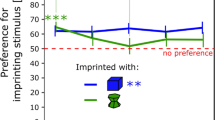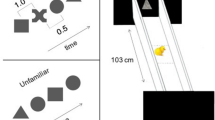Abstract
IN 1951 Ramsay1 reported observations which suggest that recognition of the home environment by precocial birds might be regarded as a form of imprinting. This view was also expressed by Thorpe2 and implies that imprinting can occur not only to a fluctuating stimulus but also to any salient feature of the natural environment. The occurrence of attachment to a stationary object has since been demonstrated, though not beyond controversy, by Hess3, Gray4, and Abercrombie and James5. Both Hess and Gray used as stimuli a black circle and a black triangle of comparable size. Young domestic chicks were exposed to one or the other of these figures for one day, having previously been reared in visual isolation; when later tested in a choice apparatus with the figures at opposite ends they showed a clear preference, in terms of approach behaviour, for the original over the new object. Abercrombie and James tested their chicks in a runway at each end of which was a continuous light, one of them being accompanied by a stationary polythene ball which served as a ‘lure’. They found that in this situation chicks eventually formed an attachment to the lure, although they required more trials for its formation than did others which had been trained with the lure accompanied by a flickering light.
This is a preview of subscription content, access via your institution
Access options
Subscribe to this journal
Receive 51 print issues and online access
$199.00 per year
only $3.90 per issue
Buy this article
- Purchase on Springer Link
- Instant access to full article PDF
Prices may be subject to local taxes which are calculated during checkout
Similar content being viewed by others
References
Ramsay, A. O., Auk, 68, 1 (1951).
Thorpe, W. H., Learning and Instinct in Animals (Methuen, London, 2nd ed., 1963).
Hess, E. H., Nebraska Symposium on Motivation, edit. by Jones, M. R. (Univ. Nebraska Press, Lincoln, Neb., 1959).
Gray, P. H., Science, 132, 1834 (1960).
Abercrombie, B., and James, H., Anim. Behav., 9, 205 (1961).
Brown, J., Occup. Psychol., 30, 169 (1956).
Harlow, H. F., and Zimmermann, R. R., Science, 130, 421 (1959).
Taylor, K. F., and Sluckin, W., Bull. Brit. Psychol. Soc., 17, No. 54, 10A (1964).
Author information
Authors and Affiliations
Rights and permissions
About this article
Cite this article
TAYLOR, A., TAYLOR, K. Imprinting to a Static Feature of the Home Environment. Nature 204, 1117–1118 (1964). https://doi.org/10.1038/2041117a0
Published:
Issue Date:
DOI: https://doi.org/10.1038/2041117a0
Comments
By submitting a comment you agree to abide by our Terms and Community Guidelines. If you find something abusive or that does not comply with our terms or guidelines please flag it as inappropriate.



